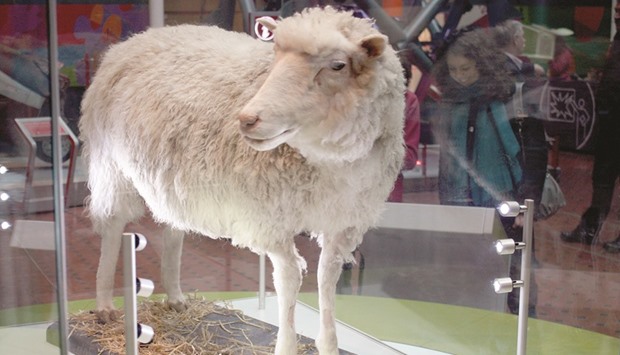Dolly is looking a bit bemused at the visitors arriving these days at the Royal Museum in Edinburgh. It was 20 years ago – February 23, 1997 – that reports surfaced about the birth of an extremely exceptional lamb.
Dolly – named after the country and western singer Dolly Parton – is now a stuffed specimen, standing inside a glass showcase.
In case you’ve forgotten, we’re talking about the world’s first cloned mammal. At the time, this sweet-looking mountain lamb triggered a wave of fear and heated debate about the ethics of science. The question on everyone’s lips: Will humans be next for cloning?
Dolly is a genetic copy of another sheep and has no biological father, created in the laboratory by means of a process called somatic cell nuclear transfer (SCNT).
Scientists Ian Wilmut and Keith Campbell of the Roslin Institute near Edinburgh were the ones to remove the nucleus containing all the animal’s genetic information from an egg cell.
The researchers then placed the nucleus in another cell from the animal’s body. This was placed in a nutrient solution, triggering the start of the division of the cell. Then this was implanted in the womb of a ewe to grow further.
Following on the sensation of Dolly, there emerged a genuine cloning race – for example in horse and cattle breeding. At the biotechnology institute in Munich, genetics researcher Christoph Then notes that “in the United States for example the sperm of cloned bulls are for sale. There are also companies that to a limited degree offer cloned racing horses.”
In South Korea, grieving dog owners can order up copies of their deceased pet. And, especially effective drug-sniffing dogs are now also being duplicated, while China has reported the birth of a cloned cow that was engineered with an additional gene to improve the quality of its meat.
Meat in Europe, meanwhile, is still far removed from such a scenario, however. If used at all, cloning is reserved for medical research. At the Ludwig-Maximilian University (LMU) in Munich, for example, animals that are ill with diabetes or cystic fibrosis are cloned.
“On these animals one can test how the illness evolves and whether certain medications are effective,” says Eckhard Wolf of the LMU genetic research centre. “This is a very important supplement to our experiments with mice.”
In such model animals the scientists will often change the genetic material in order to provide the cloned animal with specifically new characteristics.
For example, this can range from accelerated growth all the way to resistance to germs. Professor Wolf was the first scientist in Germany to clone an animal – a calf called Uschi born in 1998. “Uschi became a grandmother many times over and was clinically healthy,” he says.
Dolly wasn’t so lucky. Born July 5, 1996 in Scotland – the scientists only revealed the scientific breakthrough event to the public in February 1997 – Dolly lived in a tightly-guarded concrete building to protect her from hailstones and protesters.
She lived on a diet of pills filled with nutrients but never was permitted simply to graze on some grass. The animal was sickly – aching joints and lung ailments plagued the creature. Dolly was put down at the age of just six, about half the normal age of sheep.
But, as Uschi the cow shows, such a fate must not be typical for a cloned animal. Kevin Sinclair, a researcher at Nottingham University, carried out studies on 13 cloned sheep aged seven to nine years – 60 to 70 years in human terms.
Four of the animals – Debbie, Denise, Dianna and Daisy – were from the same cell line as Dolly, meaning they were of the same genetic material. The sheep showed no signs of premature ageing. The conclusion, the researchers said in the journal Nature Communications, is that cloned animals can lead a long and healthy life.
All the same, there is a lot of criticism of cloning of animals, among other reasons because many experiments fail and the embryos die. Veterinarian Christoph Then says, “I am opposed for animal protection reasons.”
Transparency and freedom of choice for consumers is particularly important when it comes to meat from cloned animals, he says. “In Britain, cloned animal meat is already to be found in shops.”
The most terrifying vision of many critics was the prospect of a cloned human being. In 2003, the Raelian sect – which believes mankind was created by extraterrestrials – proclaimed such human copies were now already living among us. However, no one has seen any of these creatures, and experts back then strongly doubted the claim.
Edinburgh scientist Ian Wilmut strictly opposes human cloning. “How could I ever cope with living with someone who is exactly like me?” he once asked in an interview. “I believe that most of us would find it rather difficult, having to live with ourselves.” -DPA

Dolly the cloned sheep, named after singer Dolly Parton, is now a stuffed specimen, standing inside a glass showcase.


